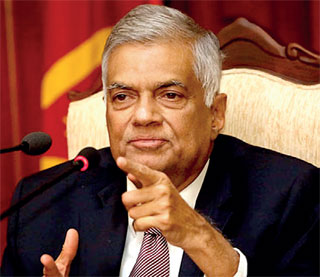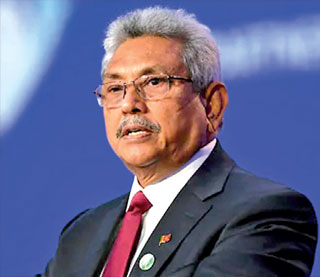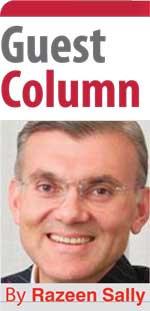Monday Dec 01, 2025
Monday Dec 01, 2025
Friday, 28 October 2022 00:00 - - {{hitsCtrl.values.hits}}

President Ranil Wickremesinghe

Gotabaya Rajapaksa

Mahinda Rajapaksa
|
 I have not written in these pages for a few years, not since I was an adviser to Ranil Wickremesinghe’s spectacularly misnamed Yahapalanaya Government until 2018. I was absent from Sri Lanka for over two years due to the pandemic, and watched the beginnings of the present catastrophe from Singapore, where I lived until recently. But I returned in April this year and spent eight weeks travelling in a crisis-ravaged island. What follows are my observations on the causes of this crisis, the present situation, and what might lie ahead.
I have not written in these pages for a few years, not since I was an adviser to Ranil Wickremesinghe’s spectacularly misnamed Yahapalanaya Government until 2018. I was absent from Sri Lanka for over two years due to the pandemic, and watched the beginnings of the present catastrophe from Singapore, where I lived until recently. But I returned in April this year and spent eight weeks travelling in a crisis-ravaged island. What follows are my observations on the causes of this crisis, the present situation, and what might lie ahead.
Three scenarios revisited: Relapse redux
In December 2016 I gave an Advocata lecture on three scenarios of Sri Lanka’s future.
Scenario One I called “Drift”, extrapolating the then present under the Yahapalanaya Government to the future. That Government squandered the golden opportunity that came with regime change in 2015. It was a total shambles. No serious reforms materialised; nepotism and corruption remained rife. It reminded me of Lyn Ludowyk’s characterisation of Sir John Kotelawala’s Government:
The actions of the prime minister and the UNP seemed to be rotating further and further on an axis of their own away from the centre of the country’s strongest emotional interests. In the end, with shows and circuses becoming more prominent as in the Marx Brothers film, the orchestra and conductor drifted farther and farther on the lake where their raft had been moored. The conductor in desperation changed the score, but both orchestra and himself were lost in the distant horizon as events panned out to the general election of April 1956 which routed the UNP and marked the end of nine years of its rule.
Following the Marx Brothers analogy, Sri Lanka would drift aimlessly into the future with a low-growth economy always verging on crisis, a debt mountain, a bloated public sector, an ossified political and business elite, third-rate institutions, simmering ethnic tensions, and overdependence on China. Most Sri Lankans would continue to be undereducated, underskilled, underemployed and underpaid, leading underdeveloped lives they would pass on to their children and grandchildren.
Scenario Two was “Take-Off”, envisioning a Sri Lanka that would achieve its long-heralded potential. Higher growth, real wages and living standards, with better education, housing and healthcare, would be driven by a productive private sector, international trade and foreign investment, drawing Sri Lanka into global value chains. This would require substantial pro-market policy and institutional reforms. A bigger economic pie would reduce ethnic tensions and promote reconciliation. Sri Lanka would forge stronger political, commercial and cultural links with its civilisational friends in the world’s liberal democracies, market economies and open societies. I added that this vision was a long way from reality, and the odds were it would not materialise.
Scenario Three was “Relapse”. A Big Man, probably a Rajapaksa, would return to power. He would promise to cleanse politics and institutions and “get things done”. He would neuter institutions such as the police, armed forces, judiciary and NGOs, and centralise patronage politics. Sri Lanka would slide back to illiberal democracy. There would be no rule of law. The economy would be state-led again. The public sector would expand, crowding out the productive parts of the private sector, international trade and non-Chinese foreign investment. The new Big Man would pander to the worst instincts of Sinhala Buddhists; ethnic tensions would be kept on the boil. Sri Lanka would again distance itself from India and the West, and become even more dependent on Chinese projects and loans.
The Relapse scenario became the dominant reality after Gotabaya Rajapaksa won the presidency decisively in late 2019. But that was not the Colombo elite consensus I found on my last pre-COVID visits in December 2019 and February 2020. That consensus was solidly behind President Rajapaksa and his Viyathmaga manifesto – another egregious example of Sri Lankan mislabelling and bombast. Tax cuts were just what the economy needed. Gota’s military discipline and his newly appointed “technocrats” would revitalise the country.
But the Rajapaksas’ prior record – economic incompetence, corruption and nepotism, their crushing of dissent and liberal institutions, human-rights abuses during and after the war, and their Sinhala-Buddhist chauvinism, demonising Sri Lanka’s minorities – taught me to be sceptical. Gota-mania also confirmed my scepticism of Colombo’s socio-economic elite, co-opted and corrupted in their bubble of wealth and power, and utterly disconnected from ordinary Sri Lankans.
The new President Rajapaksa restored the core features of his brother Mahinda’s rule pre-2015, now with himself in charge and governing through a small kitchen cabinet. The 20th Amendment, and the August 2020 parliamentary election victory that delivered the Rajapaksas an effective two-thirds majority, fully restored illiberal democracy; one family monopolised political power and extended its tentacles ever wider and deeper into the economy and society. Policymaking was top-down and ad hoc, and policies announced and implemented by diktat.
Unsurprisingly, this was not a recipe for efficient technocratic governance. This Rajapaksa Government, from beginning to end, made stupefying policy blunders born of hubris, stupidity and incompetence: a tax-cutting budget that depleted already scarce revenues and widened the fiscal and current-account deficits; feverish money-printing that stoked inflation; expanding an already bloated public sector; an overnight ban on chemical-fertiliser imports that devastated harvests of rice and other staple crops as well as tea production and exports; constantly changing price controls and import restrictions; and extra borrowing to service mounting foreign debt, tantamount to an ever-expanding Ponzi scheme.
Nepotism and corruption reached new heights. Nothing the Rajapaksas did was new to Sri Lanka, but the grand larceny of their rule, the sheer scale and brazenness of it, was unprecedented. Sri Lanka’s public institutions had been degraded for decades, but the Rajapaksas’ capture of the state, the way they packed it with relatives and cronies and gutted it of professionalism and competence, accelerated the country’s collapse.
|
The 2022 catastrophe: A brief and selective political economy
Sri Lanka is suffering its worst economic crisis since at least the 1930s. It originated in a debt-fuelled spending spree after the civil war ended in 2009. Mahinda Rajapaksa’s Government borrowed liberally abroad to fund giant infrastructure projects and an expanding public sector. The Central Bank squandered foreign reserves to defend an artificially high exchange rate. Then came Gotabaya Rajapaksa’s policy blunders. Pandemic-induced economic contraction made matters worse, as did fuel price increases and shortages triggered by the Russia-Ukraine war. Still, this is a home-grown, Rajapaksa-made crisis, not a by-product of unfavourable external circumstances. Local and foreign experts warned the Government that the debt situation was unsustainable as early as 2020. It denied reality and carried on with quick-fix quackery – until it was too late.
Rather than repeat further detail on the crisis’s features and proximate causes, well-rehearsed in these pages by Dr. Wijewardena and others, I will highlight two “deep” contributory factors.
The first is a toxic combination of populism and economic collectivism. Collectivist ideas, influential since the 1930s, prioritise State control over markets to deliver greater efficiency and equity. Political parties and successive Governments harnessed these ideas to populist means and ends: to expand State intervention, public services and the public sector, allied with an ethno-nationalist agenda favouring Sinhala Buddhists at the expense of the minorities, to enlarge their vote banks. This occurred in three phases: the road to socialism from 1956 to 1977, initiated by Mr. Bandaranaike and accelerated by Mrs. Bandaranaike’s governments, especially in the 1970s; stop-go liberalisation between 1977 and 2005, which never kicked economic and ethno-nationalist populist habits; and Rajapaksa deliberalisation and State-led expansion from 2005 until this year, paused but not reversed between 2015 and 2019.
Populism and economic collectivism have severely damaged Sri Lanka microeconomically, by diminishing productivity and wealth-generation; and macroeconomically, with chronic overspending, overborrowing, fiscal and current-account deficits, currency debasement and inflation leading to crises and 16 IMF bailouts. This year’s crisis is the worst so far, resulting from supercharged populism and economic collectivism under the Rajapaksas.
No one should underestimate the enduring power of collectivist ideas in Sri Lanka, not just among self-serving politicians and their acolytes. They pervade the thoughts of decent people, from the poor and lower middle class to the well-educated and worldly. On my travels I invariably encounter sentiments that are anti-market and favour a large, beneficent state (“if only it were run by the right people”), and self-sufficiency over dependence on imports. But these same people do not appreciate how a large state becomes captured by powerful interests and morphs into a predator and Leviathan; how protectionism in the name of self-sufficiency benefits billionaire businessmen with local monopolies and politicians in their pockets while screwing consumers; and how the whole business spins public finances out of control and precipitates a macroeconomic crisis that pauperises the poor, immiserates the middle class and accelerates a brain drain out of the country.
The second “deep” factor is Sri Lanka’s rotten and entrenched political class. I have said my piece about the Rajapaksas. What is the alternative? Sajith Premadasa and the SJB have a deserved reputation for prevarication and weakness. They have failed in Government before and appear hopelessly unequal to the country’s gargantuan challenges today. The JVP offers only recycled left-wing populism. By accepting the premiership, Ranil Wickremesinghe threw the Rajapaksas a lifeline. By manoeuvring himself into the presidency relying on their support, he kept them in the political game. He appointed a prime minister and cabinet of Rajapaksa loyalists, and ordered the army and police to clear the Aragalaya protest site.
This makes the Aragalaya victories – first ousting Mahinda and other Rajapaksas from the cabinet, and then Gotabaya as president – ring hollow. There was no “system change”. Gotabaya Rajapaksa’s unopposed return to Colombo in early September, enjoying all the privileges due to a former head of state, was proof enough that the system really had not changed. The same veterans still dominate the system, behaving as if nothing serious has changed. And the most senior veteran now sits at the top of the system.
My chief insight from my years in the company of Sri Lanka’s political elite was this: there would be no meaningful policy reforms and change for the better without fundamental institutional change that would usher in a new elite, flush out the old one, restructure decision-making, and realign incentives and interests. Sri Lanka’s public institutions limit access to a small minority of powerful insiders, who extract benefits for themselves and their patronage networks at the expense of outsiders – the vast majority of the population. Institutional reform should be about more open access and inclusive decision-making to benefit most Sri Lankans. To be clear, this should happen through peaceful constitutional change, not violent revolution. Sri Lanka has tried the latter in the north and south, and failed disastrously.
Absent institutional change and a new political class, Sri Lanka will alternate between “drift” and “relapse”, but never “take off”. Political incumbents, from the Rajapaksas, Ranil and Sajith down, will defend fortress walls to prevent such change, which would of course threaten their power and privileges. Even sensible policy wish lists are academic without institutional change, since they will invariably be blocked by the system’s insiders.
This is Sri Lanka’s institutional dilemma: fundamental change is desperately needed, but will be blocked by powerful insiders.
|
Prospects
The best economic scenario is that a new IMF program will start early next year, and that the new year will bring agreement with sovereign creditors and private bondholders on debt restructuring. IMF conditionality will require tax, monetary and some expenditure reforms. This may stabilise the economy.
But deeper structural reforms – trade and FDI liberalisation, domestic deregulation, SOE privatisation and restructuring, cutting defence spending, labour-market reforms, better targeted social transfers, and the list goes on – are highly unlikely given opposition from ministers, MPs, business cronies, unions and the military. They are essential to turn the economy round and provide livelihoods and hope for the suffering majority, but will not materialise in the political status quo.
Nor will the IMF and external creditors insist on a stabilisation package with deep structural reforms. That is totally unrealistic. IMF programs work when focused on short-term stabilisation. With domestic “ownership” (in IMF jargon), that gives breathing space for structural reforms. But the latter must be home-grown with domestic political credibility. IMF programs backfire when they overreach, do not enjoy domestic political and popular support, and are seen as an imperialistic imposition.
With status-quo politics, an optimistic scenario is that the new year will bring stabilisation of a moribund economy for a while, before creeping or lurching towards the next macroeconomic crisis when the next cycle of overspending, overborrowing and money-printing resumes. Meanwhile, prolonged and deeper mass poverty may trigger a social explosion of violence and anarchy.
Institutional change should be both political and economic. Institutional reforms on monetary, fiscal and other areas of economic policy are needed to turn opacity, arbitrariness, incompetence and corruption into transparency, predictability, competence and accountability. That should be the subject of other articles. Here I will limit myself to brief observations on desirable political system change.
Sri Lanka needs a younger and different breed of people to enter politics and march through public institutions. I hope they will come from the centre-left and centre-right, social democrats and economic liberals, but united in a commitment to liberal democracy and an open, non-communal society. They should be drawn from urban professionals and entrepreneurs, think tanks and NGOs, the Aragalaya movement (except its hard-left elements), and the diaspora.
They need one or more new political vehicles, independent of established political parties, all of which are irredeemable. They should campaign on policy and institutional reforms to improve governance, extract the country from crisis, and put it on a sustainable path of peace and prosperity. They should aim to get 10-15% of the vote in a parliamentary election, seeking to hold the balance of power and control key ministries in a new Government. I hope a new party with a pro-market policy platform would be in charge of the finance ministry.
One among many obstacles to realising this vision is the present electoral system. A different proportional-representation system might be needed to break the chokehold of the established parties, which they would of course oppose.
If I were to put a name and face to the new breed of politician Sri Lanka needs, it would be Advocata’s Dhananath Fernando: young, civic-minded, hard-working, practical, articulate, with Sinhala as his mother tongue and a humble background the other side of the tracks from the usual Colombo circles. He sits on the economic-liberal centre-right. I hope there are Dhananath Fernandos on the social-democratic centre-left, among Tamils and Muslims, and among women. The country needs a critical mass of such women and men to coalesce, mobilise and make a political breakthrough.
These are very sketchy thoughts. And all this might sound like a pipedream. The political establishment would do its utmost to prevent it from happening. Even more reason to have a serious discussion on what kind of institutional change Sri Lanka needs, going well beyond constitutional amendments, and how to achieve it realistically. This must be initiated outside Government and the established political parties.
(The writer is the author of ‘Return to Sri Lanka: Travels in a Paradoxical Island’. He was a professor at the London School of Economics and the National University of Singapore, chairman of the Institute of Policy Studies, and an adviser to the Sri Lankan Government.)